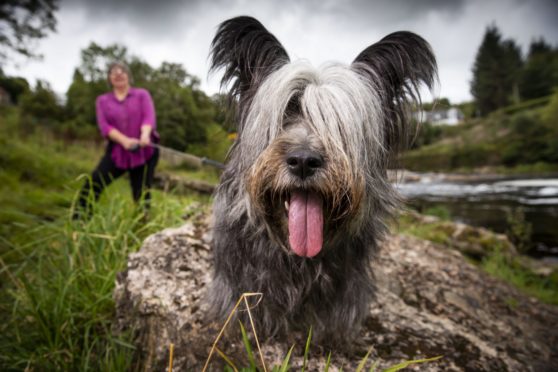
From the faithful hound who stayed by the side of Mary, Queen of Scots even after her execution to Greyfriars Bobby, diligently waiting by his late master’s grave, Skye terriers are famous for their loyalty.
Now their biggest fans are attempting to repay that loyalty as they fight to save the breed from extinction.
The Skye Terrier Club hope a combination of DNA tests, blood screenings, and even cash incentives will boost numbers in the UK and keep the breed from disappearing.
Allan Stephenson, president of the Skye Terrier Club, hopes the pedigree’s health problems can be eliminated.
“Skye terrier numbers have declined enormously since the ’80s,” he explained.
“The population has shrunk since then and the club has encouraged people to look for genetic lines in the pedigree that are healthier so we can use them to rejuvenate the breed.
“If someone imports a Skye terrier from abroad, which can improve the health of the pedigree, then we award them £1,000 as an incentive.
“But we are hoping DNA testing and building up a genetic profile of our dogs will enhance the breed standard and remove the things which trouble the terrier.”
Only 53 terriers were registered in the UK last year, and it’s thought there are fewer than a couple of hundred left.
Skye terriers are prone to a form of hepatitis which leaves them with chronic liver problems. The animals are screened for this liver issue, and the club has undertaken a programme to swab the dogs in an attempt to identify which could pass on the faulty genes.
“The more data we gather, the more likely it is we’ll be able to identify a genetic marker so we can see which lines have these health problems,” added Allan.
“Then we start to eliminate them and make the breed more resilient. We’re not scientists, but it seems like it could help.”
In partnership with Liverpool University and the Animal Health Trust, swabs are sent out to breeders around the world, who take samples from their terriers.
Not all owners are so desperate to have their dog screened, however.
“It can be a touchy subject – a lot of members were opposed to this,” said Allan. “There was a feeling that it would be a case of identifying whose dogs were somehow to blame. Owners are understandably protective of their dogs. But it’s not about that, it’s about helping to ensure the pedigree thrives.”
Curing pedigree dogs of genetic defects is being pioneered at Cambridge University’s Department of Veterinary Medicine.
Dr David Sargan has analysed the genetic results of various dog breeds and has helped reduce and even eliminated some inherited diseases.
“Breeders have been very good at eliminating diseases,” he explained. “They’ve been trying for years to remove them from pedigree lines by not breeding dogs which have these conditions – it’s an old technique.
“However some dogs carry genes but don’t express these diseases. What a test can do is identify which dogs have these genes.
“If you can recognise a mother and a father who have these genes then owners can avoid breeding them – the easiest way to do that is via a genetic test. This is handy in canine medicine and human medicine too.”
Identifying which dogs may have hidden conditions gives owners a better chance of breeding healthier puppies, according to Dr Sargan.
“Taking dogs out of the breeding pool reduces the number of dogs who might actually have good characteristics and who might not be carriers. That’s especially a problem for pedigrees which have a smaller number of dogs, like the Skye terrier.
“You want to be able to keep as many dogs in your breeding pool as possible – the more healthy genes you have, the better the gene pool and the healthier the dogs will be.
“These tests are becoming more common and easier to find. There have been a few eliminations of diseases because of these genetic tests.
“The first one we worked on was a form of inherited blindness in Irish setters. We found the lines which were carrying the mutations and we managed to find and remove the lines in the UK.”
Even if cutting-edge science can save the Skye terrier, Allan believes the breed has lost some of its appeal thanks to modern cleanliness standards.
“While they look like a very short dog, it’s actually a very big dog once its grown,” he explained. “They do lose hair yet people want to live in a hygienic bubble these days, they don’t want to see dog hair on their laminate flooring.
“But I love them. I first saw them at Crufts – I was absorbed by them. From that moment all I ever wanted was a Skye terrier.
“It’s the personality of them. As dogs they’re very compassionate about the people around them.”
From royalty to writers: How pet won hearts

The shaggy dog story of the Skye terrier dates back hundreds of years to when invading Vikings brought their diminutive hounds to Scotland’s west coast.
Bred to hunt vermin, they’ve since been championed by acting royalty, as well as genuine monarchs.
When Mary, Queen of Scots was beheaded, her faithful Skye terrier hid in the folds of her dress.
Queen Victoria bred two varieties, the drop and prick-eared, making the dog popular with nobility.
Dr Jekyll and Mr Hyde author Robert Louis Stevenson was an owner but couldn’t settle on a name. His was finally known as Bogue. And scientist Alexander Graham Bell tried to manipulate his dog’s mouth in an attempt to make it speak.
Ava Gardner had also a Skye terrier, as did the Grand Duchess Charlotte of Luxembourg and Queen Soraya of Iran.

Enjoy the convenience of having The Sunday Post delivered as a digital ePaper straight to your smartphone, tablet or computer.
Subscribe for only £5.49 a month and enjoy all the benefits of the printed paper as a digital replica.
Subscribe